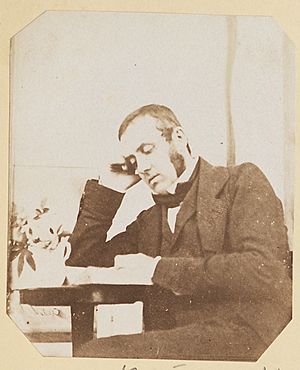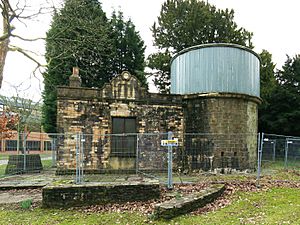John Dillwyn Llewelyn facts for kids
John Dillwyn Llewelyn (born January 12, 1810 – died August 24, 1882) was a Welsh scientist. He was a skilled botanist (someone who studies plants) and a very important early photographer. He helped create new ways to take pictures.
Contents
Early Life and Family
John Dillwyn Llewelyn was born in Llangyfelach, a town near Swansea, Wales. His father, Lewis Weston Dillwyn, was also a scientist and a member of Parliament. John's mother was Mary Dillwyn. John's sister, Mary Dillwyn, was one of the first female photographers in Wales.
When John grew up, he inherited large estates called Penllergaer and Ynysygerwn. He then added "Llewelyn" to his name. Because of his father, John met many famous scientists of his time. These included people like Sir David Brewster and Michael Faraday.
In 1833, John married Emma Thomasina Talbot. Her family was related to William Henry Fox Talbot, another very important person in the early history of photography. This connection would later help John with his own photography work. In 1835, he held an important local role as High Sheriff of Glamorgan. This meant he was the chief law enforcement officer in the county for a year.
Pioneering Photography
In 1839, new ways to take photos were announced by William Henry Fox Talbot and Louis Jacques Mandé Daguerre. John Dillwyn Llewelyn, encouraged by Henry Talbot, started his own photography experiments. He tried all the new methods available.
His very first daguerreotype (an early type of photograph) was made in 1840. Many of his early photos still exist today. These include thousands of calotype and wet collodion negatives. These are like the early versions of camera film.
Royal Photographic Society
When the Royal Photographic Society was started in 1853, John Dillwyn Llewelyn was there. He was one of the founding members of its Council. He often showed his photos in early exhibitions. He even won a silver medal at the Paris exhibition in 1855 for his photos of "Motion."
The Oxymel Process
In 1856, John announced his own special photography method called the oxymel process. This was a big deal because it allowed photographers to prepare their glass plates (which were like film) and keep them ready for many days. Before this, plates had to be used right away.
The Illustrated London News newspaper praised his discovery. They wrote that photographers could now prepare plates at home, travel, and take pictures easily. This was a huge help for people who wanted to photograph landscapes or travel.
John also took many stereo images. These are special photos that create a 3D effect when viewed with a special device. He bought a camera for his daughter Thereza Dillwyn Llewelyn to take these kinds of pictures.
John's health might have stopped him from taking photos after the late 1850s. Most of his pictures were taken around his home, Penllergare, in Wales. He also took photos in other parts of Britain, like Cornwall and Bristol. He even took some of the first photos of animals and birds at Clifton Zoo.
Other Scientific Interests
John Dillwyn Llewelyn was interested in many areas of science and technology, not just photography.
- He collected many different types of plants, creating a large botanical collection.
- He helped scientist Charles Wheatstone with the first experiments in sending messages through underwater cables. This was off the coast of Mumbles, South Wales.
- He showed off a small boat powered by an electric motor on a lake at his estate.
- He built the first private orchid house in Britain. This was a special greenhouse designed to copy the warm, steamy conditions of South American jungles where orchids grow naturally. It even had a heated waterfall!
- He was also very interested in astronomy (the study of stars and planets). He built a stone observatory (a building for looking at the sky) on his estate. This was for his daughter Thereza Dillwyn Llewelyn to use. Construction started in 1851.
Later Life and Legacy
John Dillwyn Llewelyn moved to London in 1879. He passed away on August 24, 1882, in Wimbledon. His wife, Emma, had died the year before. Both are buried at Penllergaer Church, which John had built for his family and the people working on his estate.
His oldest son, John Talbot Dillwyn Llewellyn, also became an important figure. He was High Sheriff of Glamorgan in 1878 and later a Member of Parliament for Swansea. He was made a baronet in 1890, which is a special title.
John Dillwyn Llewelyn's family had both Welsh and American roots. His great-great-grandfather, William Dillwyn, was a Quaker who moved to North America in the 1600s. Some of his family still live in the United States today.
Penllergare Today
Today, a project is working to restore the Penllergaer estate. This project uses John Dillwyn Llewelyn's old photographs to guide the restoration. They are cleaning the upper lake and fixing old steps, waterfalls, and bridges. The stone arched Llewelyn Bridge has been rebuilt, making it a unique bridge built in Britain in recent times.
Collections
John Dillwyn Llewelyn's photographic work can be seen in public collections, including:
- Swansea Museum, Swansea.



